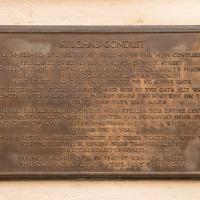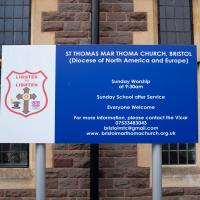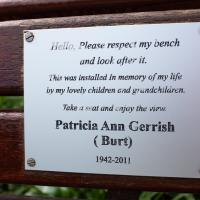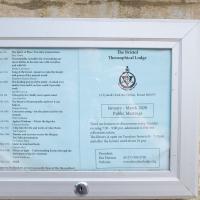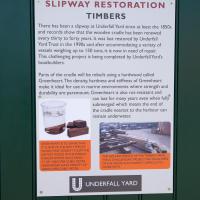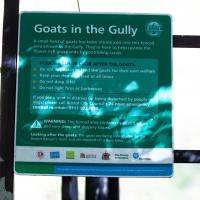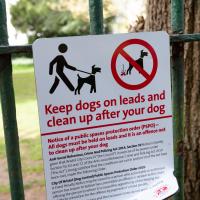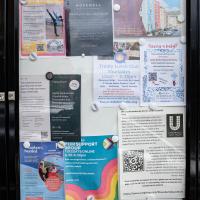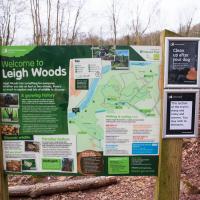Tagged: after
Doors and walls, closed paths and chalk
11 Nov 2020
I'd love to walk the Chocolate Path again at some point, but it's been closed since it started falling into the river. Still, on this wander to get a coffee I walked down a road I'd not normally use and found a door dressed up as a wall and another door that had been bricked up for real. Odd.
I also found a lovely bit of art on one of the Cumberland Piazza pillars on my way home.
Good advice
Tags: Bristol Places UK onemilematt united kingdom Cumberland Basin Flyover System graffiti flyover columns
Auto-Tags: Window Art Pink Graffiti Paint Plant Road surface Wall Magenta Font Line Material property Asphalt Tints and shades Road
Text Recognition Tags: Locok After Your Heart Locok After Your Heart
Well, it seemed like the kind of message to be spreading at the moment.
Tags: Bristol Places UK onemilematt united kingdom Cumberland Basin Flyover System graffiti flyover columns
Auto-Tags: Art Paint Font Pink Wall Asphalt Chalk Road surface Handwriting Magenta Window Tints and shades Graffiti Blackboard Building
Text Recognition Tags: Lock After Your. Hearl! Lock After Your. Hearl!
I got interested in Bristol's medieval water supplies after poking around near Jacobs Wells Road and Brandon Hill. It was during that research I found out about a pipe that's still there today, and, as far as I know, still actually functioning, that was originally commissioned by Carmelite monks in the 13th century. They wanted a supply of spring water from Brandon Hill to their priory on the site of what's now the Bristol Beacon—Colston Hall, as-was. It was created around 1267, and later, in 1376, extended generously with an extra "feather" pipe to St John's On The Wall, giving the pipework its modern name of "St John's Conduit".
St John's on the Wall is still there, guarding the remaining city gate at the end of Broad Street, and the outlet tap area was recently refurbished. It doesn't run continuously now, like it did when I first moved to Bristol and worked at the end of Broad Street, in the Everard Building, but I believe the pipe still functions. One day I'd like to see that tap running...
There are a few links on the web about the pipe, but by far the best thing to do is to watch this short and fascinating 1970s TV documentary called The Hidden Source, which has some footage of the actual pipe and also lots of fantastic general footage of Bristol in the seventies.
On my walk today I was actually just going to the building society in town, but I decided to trace some of the route of the Carmelite pipe, including visiting streets it runs under, like Park Street, Christmas Street, and, of course, Pipe Lane. I also went a bit out of my way to check out St James' Priory, the oldest building in Bristol, seeing as it was just around the corner from the building society.
There are far too many pictures from this walk, and my feet are now quite sore, because it was a long one. But I enjoyed it.
Tags: Bristol Places UK onemilematt united kingdom City Centre St John on the Wall St John's Church St. John's Conduit old city
Auto-Tags: Brown Wood Font Commemorative plaque History Interior design Rectangle Memorial Hardwood
Text Recognition Tags: STUOHNS CONDUIT GRANTED TO THE VESTRY OF S JOHN IN THE 14TH CENTURY THE SOARCE OB SOPPLY LS AT TEE FO O AK STREET WATER IS CONVEYED SY TER DIRE OROM THE CARMBLITE PRIORY CISTERN- DN THE COLSTON ALL SITE-TEROUGH 2OST STREET AND CHRISTNLAS STREET TO ST. JOHNS GATE T ORIGINAIEY STOOD ON THE INNER SIDE OF THE GATE BUT WS MOVED TO TS RESENI SITE IN L WHEN THE FOOTWAY ON THE BASTERN SIDE OR TASGATE WAS MADE AFTER THE SUPPRESSION OF THE KORASTEUIS THE INTIRE COST OF MAINTENANCE AND REPAIR CFTRE PIPE DEVOLVED UPON THE CHURCHWARDENS AND VESTRY SONETIAEN YAKINE HE WHOLE PARISH REVENJE BO AYBAR IN 1365 AFTER SEVERE DROUCHT THE DEEDS TOGETHER WITH THE RESPONSIBILTTY SOR UPKEBE WERE TRANSFERRED TO THE LOCAL BORRD OR EBALTH DURING THE AIR RAIDS OF 1940T WAS FOR A TIME THE SOLE WATER SAPPLYN THE FART OF THE CTY STUOHNS CONDUIT GRANTED TO THE VESTRY OF S JOHN IN THE 14TH CENTURY THE SOARCE OB SOPPLY LS AT TEE FO O AK STREET WATER IS CONVEYED SY TER DIRE OROM THE CARMBLITE PRIORY CISTERN- DN THE COLSTON ALL SITE-TEROUGH 2OST STREET AND CHRISTNLAS STREET TO ST. JOHNS GATE T ORIGINAIEY STOOD ON THE INNER SIDE OF THE GATE BUT WS MOVED TO TS RESENI SITE IN L WHEN THE FOOTWAY ON THE BASTERN SIDE OR TASGATE WAS MADE AFTER THE SUPPRESSION OF THE KORASTEUIS THE INTIRE COST OF MAINTENANCE AND REPAIR CFTRE PIPE DEVOLVED UPON THE CHURCHWARDENS AND VESTRY SONETIAEN YAKINE HE WHOLE PARISH REVENJE BO AYBAR IN 1365 AFTER SEVERE DROUCHT THE DEEDS TOGETHER WITH THE RESPONSIBILTTY SOR UPKEBE WERE TRANSFERRED TO THE LOCAL BORRD OR EBALTH DURING THE AIR RAIDS OF 1940T WAS FOR A TIME THE SOLE WATER SAPPLYN THE FART OF THE CTY
A London Wander in Southville
10 Apr 2021
There's a bit of Southville that I've been meaning to get to for some time, where the streets seem to take some strong inspiration from London. There's a Camden Road that crosses with an Islington Road, and a Dalston Road, even an Edgeware Road. For me these names are more evocative than the rather more exotic names I passed by to get there—Sydney Row or Hanover Place, say, because I've actually been to the places in London. The last time I was in Islington I saw Monkey Swallows the Universe play at The Angel, and I can't think of Camden without remembering a gondola trip with my friend Tara where a cheery youth played Beatles music for us on a saz...
I really liked this little area, with its mostly well-kept pretty houses and hints here and there of the creative side of the residents. It's arty and down-to-earth at the same time, and I wouldn't mind living there, I think.
On the way there I got the chance to walk through Underfall Yard for the first time in a while, and on the way back I had my first take-away hot food for many months, grabbing some crispy fried squid from the excellent Woky Ko at Wapping Wharf.
It's the Malankara Mar Thoma Syrian Church, often shortened to Mar Thoma Church:
Reformed Oriental church based in Kerala, India. While continuing many of the Syriac high church practices, the church is reformed in its theology and doctrines. It employs a reformed variant of the West Syriac Rite Divine Liturgy of Saint James, translated to Malayalam.[
It surprised me to find it on a random street in Bedminster, but I don't know much about religion, or Bristol's Syrian community, assuming that that might be the flock, in general?
Tags: Bristol Places UK onemilematt united kingdom Bedminster Southville
Auto-Tags: Daytime Window Fixture Building material Brick Font Real estate Facade Signage Gas Composite material Rectangle Brickwork Advertising Sign
Text Recognition Tags: ST THOMAS MAR THOMA CHURCH, BRISTOL (Diocese of North America and Europe) LIGHTED TO Sunday Worship at 9:30am LIGHTEN Sunday School after Service Everyone Welcome For more information, please contact the Vicar 07533483043 bristolmtc@gmail.com www.bristolmarthomachurch.org.uk ST THOMAS MAR THOMA CHURCH, BRISTOL (Diocese of North America and Europe) LIGHTED TO Sunday Worship at 9:30am LIGHTEN Sunday School after Service Everyone Welcome For more information, please contact the Vicar 07533483043 bristolmtc@gmail.com www.bristolmarthomachurch.org.uk
The Mall Gardens
19 Apr 2021
Just a quick errand to the Post Office to send off Mollog's Mob, but afterwards I bought a flat white and a new plant from Foliage Cafe and headed for The Mall Gardens to enjoy sitting in the sun and reading a book on the first day this year that's been properly warm enough for it. Nice.
The Mall Gardens does actually have some signs up letting people know it's a public garden, but I think it was only my researches for this project that brought the number of public gardens there are in Clifton to my attention, and reminded me that I could make use of this space in Clifton Village, a little closer to the coffee shops and a little more sheltered than Clifton Down.
I did. It was a good bench.
Tags: Bristol Places UK onemilematt united kingdom Clifton Village bench Patricia Ann Gerrish The Mall Garden
Auto-Tags: Plant Wood Rectangle Font Terrestrial plant Groundcover Grass Tree Signage Landscape Commemorative plaque Nature reserve Sign Natural landscape Address sign
Text Recognition Tags: Hello, Please respect my bench and look after it. This was installed In memory of my life by my lovely children and grandchildren. Take a seat and enjoy the view. Patricia Ann Gerrish ( Burt) 1942-2011 Hello, Please respect my bench and look after it. This was installed In memory of my life by my lovely children and grandchildren. Take a seat and enjoy the view. Patricia Ann Gerrish ( Burt) 1942-2011
I managed to knock off a reasonable chunk of the roads I had left to walk around the University at the north-eastern extremity of my mile on this nice sunny walk. As well as being impressed by the number of big townhouses now occupied by various departments, I took some time on my way there to check out a war memorial, and some time on the way back to do a little extra wandering of Berkeley Square.
The Theosophical Society also lets its lodge be used by a variety of other organisations, including the Bristol Dowsers; a branch of Carlos Castaneda's Tensegrity folk (some of the videos of Tensegrity are quite something); a meditation group; and the local branch of the White Eagle Lodge, founded by a medium who received various teachings from the eponymous founder.
Given that those are the groups who openly practise there, I can only imagine the list of occult factions who use the rooms on other days...
Tags: Bristol Places UK onemilematt united kingdom Clifton Bristol Theosophical Lodge Theosophical Lodge theosophy
Auto-Tags: Rectangle Font Wood Commemorative plaque Landscape Symmetry History Memorial Public utility Circle Interior design
Text Recognition Tags: १८का Noy The Bristol Ihe Sprit at a Teabe ptia Theosophical Lodge ianer hatties becs vanale Sengtihe fesot-mt evkettee d prerd the rall Maten a Me mh Ihe bshng pewerthe id- det trdil d werk Taagrity orul adaat ind 14 Terudals Pukd. C. ri BS Y In kiry of lepale sad be January - March 2020 Public Meetings Mign e h Coesces catag -ke ptaette te Fe Ai d Wtheeg de l Acher Mad Adeiheld wel o Alke ley There are lectures or discuesionsaery Tday evening 70- 9:00 pm almisioe is te hit collectuns takem The libwary is open on Temdays Irom457m and after the lectune until about io pm. Mar un Te ed m thto Tee Tube tut Hes Oetinindan N enttigr t g kat he atda fne Prsident (OL17) 9047n5 www.beisthedodge ang Hei Hanon Webshe १८का Noy The Bristol Ihe Sprit at a Teabe ptia Theosophical Lodge ianer hatties becs vanale Sengtihe fesot-mt evkettee d prerd the rall Maten a Me mh Ihe bshng pewerthe id- det trdil d werk Taagrity orul adaat ind 14 Terudals Pukd. C. ri BS Y In kiry of lepale sad be January - March 2020 Public Meetings Mign e h Coesces catag -ke ptaette te Fe Ai d Wtheeg de l Acher Mad Adeiheld wel o Alke ley There are lectures or discuesionsaery Tday evening 70- 9:00 pm almisioe is te hit collectuns takem The libwary is open on Temdays Irom457m and after the lectune until about io pm. Mar un Te ed m thto Tee Tube tut Hes Oetinindan N enttigr t g kat he atda fne Prsident (OL17) 9047n5 www.beisthedodge ang Hei Hanon Webshe
I'm afraid that this is a bit of a badly-curated wander, where I mostly just popped out to find out a little of the history of Underfall Yard and poke around the various open workshops, and, in hindsight, really didn't take pictures in any kind of coherent order. So there's a lot of pictures, but they don't really tell the story that, in hindsight, I seem to have been trying to tell, of the unusual electrical substation in Avon Crescent, the Bristol Electricity that predates the National Grid but is still in use, the history of the hydraulic power house... It's a bit of a mess.
But I suppose sometimes these wanders—always chronologically presented in the order I walked and took photos—simply will sometimes be a bit of a mess. Let's hope you still get something out of it, anyway...
I only found out from a recent Times crossword that "shivers" are splinters.
Tags: Bristol Places UK onemilematt united kingdom Hotwells Underfall Yard Spike Island Docks Heritage Weekend
Auto-Tags: Motor vehicle Font Poster Signage Vehicle Advertising Landscape Soil Banner Recipe Sign Luxury vehicle Transport Aircraft Rock
Text Recognition Tags: SLIPWAY RESTORATION TIMBERS There has been a slipway at Underfall Yard since at least the 1850s and records show that the wooden cradle has been renewed every thirty to forty years. It was last restored by Underfall Yard Trust in the 1990s and after accommodating a variety of vessels weighing up to 150 tons, it is now in need of repair. This challenging project is being completed by Underfall Yard's boatbuilders. Parts of the cradle will be rebuilt using a hardwood called Greenheart The density, hardness and stiffness of Greenheart make it ideal for use in marine environments where strength and durability are paramount. Greenheart is also rot-resistant and can last for many years even when fully submerged which means the end of the cradle nearest to the harbour can remain underwater. GREENHEART n so bevSETHAT THONE OFTHE EW TSOr WOOD THAT DORINT OATHE sornst WOO0INTHEWORLD BALSA WHCH HASA DEND TY OF 1KG R CUBIC ETRL CABINHEART HASA DNSITY OF ID40 KG PE CUBICHETR THE SZFANDwtICHT OFTHETHIEEMA THISA CHA vON HOECY THE TOUHES OF TH WOOD ALO HAEESIT DCAT TO WOM WITH UNDERFALL YARD SLIPWAY RESTORATION TIMBERS There has been a slipway at Underfall Yard since at least the 1850s and records show that the wooden cradle has been renewed every thirty to forty years. It was last restored by Underfall Yard Trust in the 1990s and after accommodating a variety of vessels weighing up to 150 tons, it is now in need of repair. This challenging project is being completed by Underfall Yard's boatbuilders. Parts of the cradle will be rebuilt using a hardwood called Greenheart The density, hardness and stiffness of Greenheart make it ideal for use in marine environments where strength and durability are paramount. Greenheart is also rot-resistant and can last for many years even when fully submerged which means the end of the cradle nearest to the harbour can remain underwater. GREENHEART n so bevSETHAT THONE OFTHE EW TSOr WOOD THAT DORINT OATHE sornst WOO0INTHEWORLD BALSA WHCH HASA DEND TY OF 1KG R CUBIC ETRL CABINHEART HASA DNSITY OF ID40 KG PE CUBICHETR THE SZFANDwtICHT OFTHETHIEEMA THISA CHA vON HOECY THE TOUHES OF TH WOOD ALO HAEESIT DCAT TO WOM WITH UNDERFALL YARD
The more I research it, the more I find that Hotwells had far better transport links back in Victorian and Edwardian times than it has today. Along with buses that went to more useful places than the City Centre, there were trams, the funicular up to Clifton, the landing stage for paddle steamer services and two railway stations all within easy walking distance of me.
Today I took a day off work as preparation for doing the bookkeeping for my tax return1, and took a wander along to the site of what would have been my nearest station, Hotwells (or Clifton, as it started out in life), nestled in the shadow of the suspension bridge, the Bristol terminus of the Bristol Port Railway and Pier.
From there I wandered down the Portway, following the original line, until I got to the area around Sneyd Park Junction, where the tunnel from the slightly later Clifton Extension Railway joined up with this originally-isolated BPR line. Then I headed up to Clifton through the "goat gully" at Walcombe Slade, seeing the few above-ground bits of evidence of the tunnel (which is still in regular use) along the way.
It was a lovely day, and a good walk, and it was interesting to daydream of the times when I could have walked a few minutes from my flat down to Dowry Parade, caught a short tram ride to Hotwells Stations, and then headed from there to Avonmouth, perhaps even to board a transatlantic passenger service. The completion of the Clifton Extension Railway that linked the Avonmouth station with Temple Meads made relatively direct transatlantic travel from London via Bristol possible, with passengers travelling up from Paddington to Temple Meads, on to Avonmouth on the Clifton Extension Railway and Port Railway and Pier line, then perhaps catching a Cambpell's paddle steamer—which sometimes acted as tenders for large steamers—to a larger ship that was headed out for Canada, say.
1 I've learned that the best approach is to take two days off and deliberately do something that's not my bookkeeping on the first day, as otherwise I just inevitably end up procrastinating and feeling guilty on the first day no matter what. I have an odd brain, but at least I'm learning strategies for dealing with its strange ways as I get older...
2 Information mostly gleaned from Colin Maggs' The Bristol Port Railway & Pier and the Clifton Extension Railway, The Oakwood Press, 1975.
People know this as the "goat gully" these days, but the official name is Walcombe Slade. (So valleyish they named it twice, perhaps, as both "combe" and "slade" mean "valley".)
Tags: Bristol Places UK onemilematt united kingdom Goat Gully Gully Walcombe Slade
Auto-Tags: Font Billboard Gas Poster Display device Signage Advertising City Sign Water Tree Banner Electric blue Machine Multimedia
Text Recognition Tags: Goats in the Gully A small herd of goats has been introduced into this fenced area known as the Gully. They're here to help restore the flower-rich grasslands by controlling scrub. PLEASE HELP US LOOK AFTER THE GOATS: Do not appoachoteed the goats for their own welfare Keep your dog oead at all times Do not drop litter Do not light fires or barbecues If you see a goat in distres (or being disturbed by people dogs) please call Bristol City Council's24 hour emergency control number: 0117 9222050 WARNING: The fenced area contains open eliff dges and very steep and slippery slopes Looking after the goats: Thu goats are being looed after by the Downs Ranger's team and are checked on a daly basi. The Goats in the Gully A small herd of goats has been introduced into this fenced area known as the Gully. They're here to help restore the flower-rich grasslands by controlling scrub. PLEASE HELP US LOOK AFTER THE GOATS: Do not appoachoteed the goats for their own welfare Keep your dog oead at all times Do not drop litter Do not light fires or barbecues If you see a goat in distres (or being disturbed by people dogs) please call Bristol City Council's24 hour emergency control number: 0117 9222050 WARNING: The fenced area contains open eliff dges and very steep and slippery slopes Looking after the goats: Thu goats are being looed after by the Downs Ranger's team and are checked on a daly basi. The
Easter Monday Gardens and Flowers
18 Apr 2022
I didn't really set out with a theme of flowers and gardens in mind for this walk. I just fancied heading up to Clifton Village to get lunch. As it turned out, though, Spring was springing, so a minor theme emerged as I started off with the graveyard flowers of Hope Chapel and wandered up to see the beginnings of the new wildflower garden at Clifton Hill Meadow.
There's been some commotion on Nextdoor about the recent appearance of this sign. Lots of people who have been letting their dogs off their leads in the churchyard for decades have been rather up in arms. I'm not sure there's actually much danger of the rozzers issuing ASBOs or fines to the locals for that kind of infraction, though.
Tags: Bristol Places UK onemilematt united kingdom Clifton Village Clifton St Andrew's churchyard birdcage walk Lime Walk
Auto-Tags: Green White Nature Natural environment Grass Font Biome Line Plant Public space Woody plant Tree Signage Motor vehicle Street sign
Text Recognition Tags: ㅅ Keep dogs on leads and clean up after your dog Notice of a public spaces protection order (PSPO)- All dogs must be held on leads and it is an offence not to clean up after your dog Anti-Social Behaviour Crime And Policing Act 2014, Section 59Notice is hereby given that Bristol City Council (the Council) in exercise of its powers under Section 59, 63 and 72 of the Anti-social Behaviour, Crime and Policing Act 2014 The Act, being satisfied that the conditions set out in section 59 of the Act have been met, made the following Onder City Of Bristol (Dog Control) Public Spaces Protection Order 2020. A Fored Penalty Notice may be issued to a person who a comitable or authorised person has reason to believe has committed an offence in relation to this One offering the person to whom it is issued the opportunity of dischinging any lability to conviction for the offence by payment of a fiend penalty Scene dog fouling provisions and the Exclusion Zones de not app assistance dogs Further information about the PSPO and the front of the Onder can be found at Public Space Protection (PSPO)-bristol.gov.uk ㅅ Keep dogs on leads and clean up after your dog Notice of a public spaces protection order ( PSPO ) All dogs must be held on leads and it is an offence not to clean up after your dog Anti - Social Behaviour Crime And Policing Act 2014 , Section 59Notice is hereby given that Bristol City Council ( the Council ) in exercise of its powers under Section 59 , 63 and 72 of the Anti - social Behaviour , Crime and Policing Act 2014 The Act , being satisfied that the conditions set out in section 59 of the Act have been met , made the following Onder City Of Bristol ( Dog Control ) Public Spaces Protection Order 2020 . A Fored Penalty Notice may be issued to a person who a comitable or authorised person has reason to believe has committed an offence in relation to this One offering the person to whom it is issued the opportunity of dischinging any lability to conviction for the offence by payment of a fiend penalty Scene dog fouling provisions and the Exclusion Zones de not app assistance dogs Further information about the PSPO and the front of the Onder can be found at Public Space Protection ( PSPO ) -bristol.gov.uk
Nipping Up the Zig Zag to the Shops
19 Aug 2023
It's been a long while since I did one of these walks.
I'm thinking of finishing up the project by walking one or two last bits of road, thus being able to declare with all honesty that I've done my best to walk every public road within my mile (and quite a few alleyways besides.) As a prelude, and just because I felt like it, I decided to drag out the camera and GPS on this little wander to the local shops.
More notices, including a couple of newcomers to the local businesses: Hopewell, an estate agency, has opened up just down Hopechapel Hill in the place of The Landmark Practice (an environmental consultancy firm that seem to have moved out to Long Ashton) and HappyBack, who I'd noticed appearing down on the Hotwell Road a month or two ago.
Tags: Bristol Places UK onemilematt united kingdom Clifton Village Hotwells Clifton
Auto-Tags: Poster Font Gas Signage Advertising Facade Display board Billboard Town City Machine Transport
Text Recognition Tags: SAVE JACOBS WELLS your We W ty WS Na à Order w a gratyf Lauan ya wld worldcat HERE THE PETI Cale wwwwww CHBUEC C www d Dabe 17 TANTO F www. 0-100 Your journey is our journey and we are here to help you every step of the way Wend fpwith vir Ourica apteert papper mating nything t neces or Sc ng vs Shack and petere p FM 2 yan unteers Needed 0/0 70-23 DAN HappyBack Find Ho D Highly experienced Physiotherapy. Osteopathy and H® Massage specialists, helping you to get your happy back! W Lifeskills Lifeskills Learning for Living Py Acad Marg back. people to join our amazing toomer volunteers Oxime ww We are your new neighbours! pelare a prsity independent state aguny tinging together every best o ort, medium Alongtam ss and mes for sale across the city ravis A NEW Ma # HOPEWELL Come and say hello at our new offic orated at Hope Chcel House Hone Chapel Hill BSB IND 0117 911 8663 CERED ww are acest (10-only) og for new SANT FREE PEER SUPPORT GROUP TUESDAYS ONLINE 6.30-8.30pm 24ury Facilitated by LGBTQIA people Safe, nonjudgemental, confidential space to discuss mental wellbeing with other LGSTOLA+people Trinity Lunch Club Thursdays 10am-3:30pm Morning Coffee Armchair Excises 3 Course Home Cooked Lunch CET ARTIN Quiz Activities Tea & Biscuits For more information Call 07458 300 210 or email tes@holytrinityhotwells.org Holy Trinity Church serving the communities of Hotwells, Cliftonwood, Saike Island, Harboursie holytrinityhotwells.org Alexander May Having a baby? 42- AU You and your birth partner weinstela Calm Births Hypnobirthing FREE TASTER SESSION, online with Dolanan Monday th September OXO 7.30pm P By placeb www.dealbws.com We are devastated by the fire at the Underfall Yard. fre The fee has destroyed the heart of the Yard where most of the boat building activity takes place and tenant's businesses and boats have. been ruined. Thankfully no one was killed and no on was injured, but a lot of people in the Underfall Yard community have been impacted our staff, our tenants, our volunteers and our neighbours on Avon Crescent and Nova Scotia Place. Our hearts are with them and we are supporting our tenants as best we can. P DARO l HIER UNDERFALL YARD TRUST The Underfall Yard Trust was formed i the 1990's to bring the Underfall Yard out of dereliction, to look after the historio buildings, to shine a light on Bristoll's engineering harbour heritage and to promote traditional marine skills. In light of the devastation at the Yard, those aims remain as relevant now as they were then, SE We absolutely are committed to rebuilding the Underfall Yard and continuing the charity's work, If you would like to support the Trust, please see our JustGiving page, scan the QR code or alternatively, there is a donation box located on the Café till. https://www.justgiving.com/theunderfallyardtrust SAVE JACOBS WELLS your We W ty WS Na à Order w a gratyf Lauan ya wld worldcat HERE THE PETI Cale wwwwww CHBUEC C www d Dabe 17 TANTO F www . 0-100 Your journey is our journey and we are here to help you every step of the way Wend fpwith vir Ourica apteert papper mating nything t neces or Sc ng vs Shack and petere p FM 2 yan unteers Needed 0/0 70-23 DAN HappyBack Find Ho D Highly experienced Physiotherapy . Osteopathy and H® Massage specialists , helping you to get your happy back ! W Lifeskills Lifeskills Learning for Living Py Acad Marg back . people to join our amazing toomer volunteers Oxime ww We are your new neighbours ! pelare a prsity independent state aguny tinging together every best o ort , medium Alongtam ss and mes for sale across the city ravis A NEW Ma # HOPEWELL Come and say hello at our new offic orated at Hope Chcel House Hone Chapel Hill BSB IND 0117 911 8663 CERED ww are acest ( 10 - only ) og for new SANT FREE PEER SUPPORT GROUP TUESDAYS ONLINE 6.30-8.30pm 24ury Facilitated by LGBTQIA people Safe , nonjudgemental , confidential space to discuss mental wellbeing with other LGSTOLA + people Trinity Lunch Club Thursdays 10 am-3:30pm Morning Coffee Armchair Excises 3 Course Home Cooked Lunch CET ARTIN Quiz Activities Tea & Biscuits For more information Call 07458 300 210 or email tes@holytrinityhotwells.org Holy Trinity Church serving the communities of Hotwells , Cliftonwood , Saike Island , Harboursie holytrinityhotwells.org Alexander May Having a baby ? 42 AU You and your birth partner weinstela Calm Births Hypnobirthing FREE TASTER SESSION , online with Dolanan Monday th September OXO 7.30pm P By placeb www.dealbws.com We are devastated by the fire at the Underfall Yard . fre The fee has destroyed the heart of the Yard where most of the boat building activity takes place and tenant's businesses and boats have . been ruined . Thankfully no one was killed and no on was injured , but a lot of people in the Underfall Yard community have been impacted our staff , our tenants , our volunteers and our neighbours on Avon Crescent and Nova Scotia Place . Our hearts are with them and we are supporting our tenants as best we can . P DARO l HIER UNDERFALL YARD TRUST The Underfall Yard Trust was formed i the 1990's to bring the Underfall Yard out of dereliction , to look after the historio buildings , to shine a light on Bristoll's engineering harbour heritage and to promote traditional marine skills . In light of the devastation at the Yard , those aims remain as relevant now as they were then , SE We absolutely are committed to rebuilding the Underfall Yard and continuing the charity's work , If you would like to support the Trust , please see our JustGiving page , scan the QR code or alternatively , there is a donation box located on the Café till . https://www.justgiving.com/theunderfallyardtrust
Leigh Woods Walk
14 Mar 2021
An enormous walk today, or at least it felt enormous. My feet are sore, anyway. I started off recreating a couple of local historical photos in Hotwells, but then headed for my traditional walk along the towpath in the Avon Gorge to the far extreme of Leigh Woods, up and through the woods to the height of the Suspension Bridge, finally crossing into Clifton Village for a well-deserved vanilla latte.
I say "traditional" because this used to be a very regular route for me, first walking, years and years ago, and later jogging—this route combined with a circuit of the Downs on the other side used to be my way of making sure I was fit to do a half-marathon (I did six of them in total, between 2010 and 2014).
I miss the routine of this walk, even though it's a long way and it used to pretty much wipe me out when I did it—I'd come back home and collapse and do very little for the rest of the day. But perhaps that's what Sundays are for, and I should try to remember that.
Doing this walk regularly was quite a meditative experience. Not so much of that today, but once I got to the further extreme of the towpath, where the roar of the Portway traffic on the other side of the river dwindles and I turned into Leigh Woods to climb ever closer to birdsong and further from rushing cars, I did seem to recapture a little of the feeling of previous walks. (I would say my mind cleared, but I was mentally singing along to Life Without Buildings' The Leanover for most of the wander. There are worse songs to have stuck in one's head, though; it's a great track...)
Anyway. Apparently the walk made me more likely to ramble in words, too. I'll stop now :)
Tags: Bristol Places UK onemilematt united kingdom Leigh Woods forest woods
Auto-Tags: Plant Plant community Ecoregion Natural landscape Map Tree Land lot Vegetation Grass Sky Font Landscape Adaptation Groundcover Recreation
Text Recognition Tags: Clean up after your dog Welcome to Kay Leigh Woods Leigh Wsos hes sanetng ter eryone, whetwo much to eplon and lats ot wid to dhcover n foot ar hook, thare's A growing history This section of the bal is stoep and rocky and uneven. Yeu may whth to dnnt ing ing s Discover wildtu Paradioe Bottum Clean up after your dog Welcome to Kay Leigh Woods Leigh Wsos hes sanetng ter eryone, whetwo much to eplon and lats ot wid to dhcover n foot ar hook, thare's A growing history This section of the bal is stoep and rocky and uneven. Yeu may whth to dnnt ing ing s Discover wildtu Paradioe Bottum


